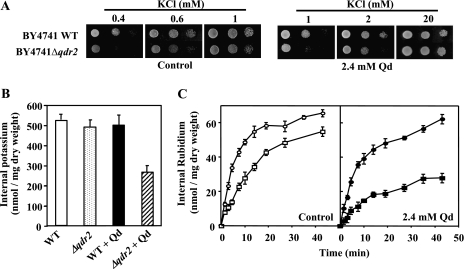FIG. 1.
QDR2 deletion increases the requirement for K+ by reducing K+ (Rb+) uptake, this effect being aggravated under quinidine stress. (A) Growth of S. cerevisiae BY4741 (parental strain) and of the Δqdr2 deletion mutant in agar plates with ammonium phosphate medium supplemented with increasing K+ concentrations, in the presence or absence of quinidine. Serial dilutions (1:1, 1:5, and 1:10, from left to right) of a cell suspension were spotted in agar plates, and growth was observed after 3 to 5 days of incubation, depending on growth kinetics. (B) Effect of quinidine on the K+ content of the parental strain BY4741 (white and black bars) and the Δqdr2 mutant (dotted and striped bars). Cells were grown as described in Materials and Methods and incubated in fresh medium, either in the absence (white and dotted bars) or in the presence (black and striped bars) of quinidine (4.1 mM). Data are means ± standard deviations (SD) for three independent experiments. (C) Rb+ uptake in the BY4741 parental strain (○ and •) and in the Δqdr2 mutant (□ and ▪), in the absence (control) or in the presence of 2.4 mM quinidine. Cells of the wild type and the mutant were grown and treated as described in Materials and Methods. At time zero, RbCl (35 mM) was added to the uptake buffer. Then, cell samples were taken and internal Rb+ was determined. Data are means ± SD for three independent experiments. WT, wild type; Qd, quinidine.

